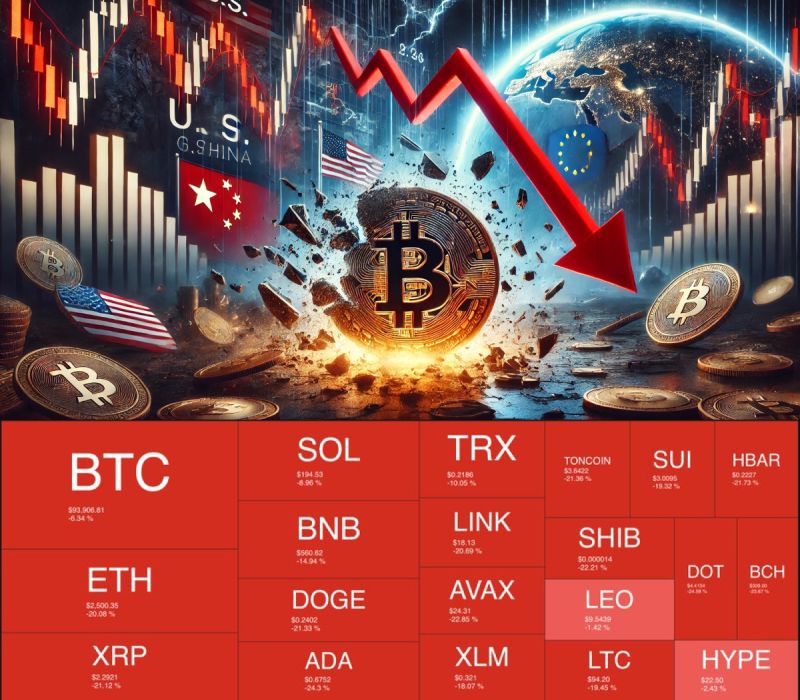The crypto world is no stranger to volatility, but yesterday’s market carnage was unlike anything we’ve seen before. Over $800 billion evaporated from the crypto market, and more than $800 billion evaporated from the crypto market, and more than $2.24 billion in leveraged positions were liquidated in a single day. To put this into perspective, this crash was even more severe than the Terra/LUNA collapse and the FTX blow-up.

Was it geopolitical tension? Market volatility? Or something deeper at play? Let’s break it down.
Leverage is a double-edged sword. On one hand, it allows traders to amplify their gains. On the other, it exposes them to catastrophic losses. When traders borrow funds to open leveraged positions, they’re required to maintain a certain margin. If the market moves against them and they can’t cover the margin, their positions are automatically liquidated by brokers.
This creates a vicious cycle: liquidations trigger sell-offs, which push prices lower, leading to more liquidations. Yesterday’s $2.24 billion liquidation event is a stark reminder of how this mechanism can amplify volatility and turn a market correction into a full-blown crash.
The lesson here is clear: leverage is a powerful tool, but it comes with immense risks. Traders need to be cautious, and the industry needs better safeguards to prevent these cascading effects.
Market makers play a critical role in crypto markets. They provide liquidity, tighten spreads, and enable seamless trading. Without them, markets would be far more volatile and illiquid. However, their role during market crashes has come under scrutiny.
Take Wintermute, for example. Allegations have surfaced that they dumped tokens during market crashes while acting as market makers for those same tokens. This creates a potential conflict of interest. During the Terra/LUNA collapse, similar accusations were leveled against market makers, with claims that they exacerbated the panic by selling tokens while market making.
While market makers are essential to the ecosystem, their actions during times of crisis can have far-reaching consequences. The crypto industry needs more transparency and oversight to ensure that market makers act in good faith and don’t exploit their position for profit.
Here’s the truth: market makers aren’t in the business of betting on price direction. Their primary goal is to profit from spreads and trading volume. However, during market crashes, they may sell tokens to manage risk, which can create the perception of market manipulation.
This is a delicate balancing act. On one hand, market makers need to protect their positions. On the other, their actions can inadvertently fuel panic and deepen market declines. The crypto industry needs clearer guidelines and more transparent practices to address this issue.
Over the weekend, reports emerged that Binance sent $32 million in SOL to Wintermute, while Coinbase sent $32million in SOL to Wintermute, while Coinbase sent $30 million in USDC. Data suggests that market makers may have sold SOL to push prices lower, triggering liquidations, only to buy back at depressed levels. This practice, known as “liquidation hunting,” is controversial.
While it’s possible that Wintermute was simply rebalancing liquidity between exchanges, the optics are troubling. Liquidation hunting crushes leveraged traders and benefits market makers and exchanges. It raises questions about whether the system is being gamed at the expense of retail investors.
Liquidation cascades aren’t just bad for traders—they’re a systemic risk for the entire crypto industry. When auto-liquidation algorithms spiral out of control, they can wipe out billions, destabilize markets, and erode trust.
To address this, the industry needs:
- Smarter liquidation protocols that minimize cascading effects.
- More transparent market-making practices to rebuild trust.
- Stronger safeguards against manipulation and conflicts of interest.
💬 What Do You Think?
The events of the past few days have sparked intense debate. Do you think market makers and exchanges manipulate liquidations for profit? Or are liquidations simply the price we pay for the benefits of leverage?
As someone who has been deeply involved in the crypto industry, I believe this is a wake-up call. We need to address these issues head-on to build a more resilient and trustworthy ecosystem. The future of crypto depends on it.
No responses yet